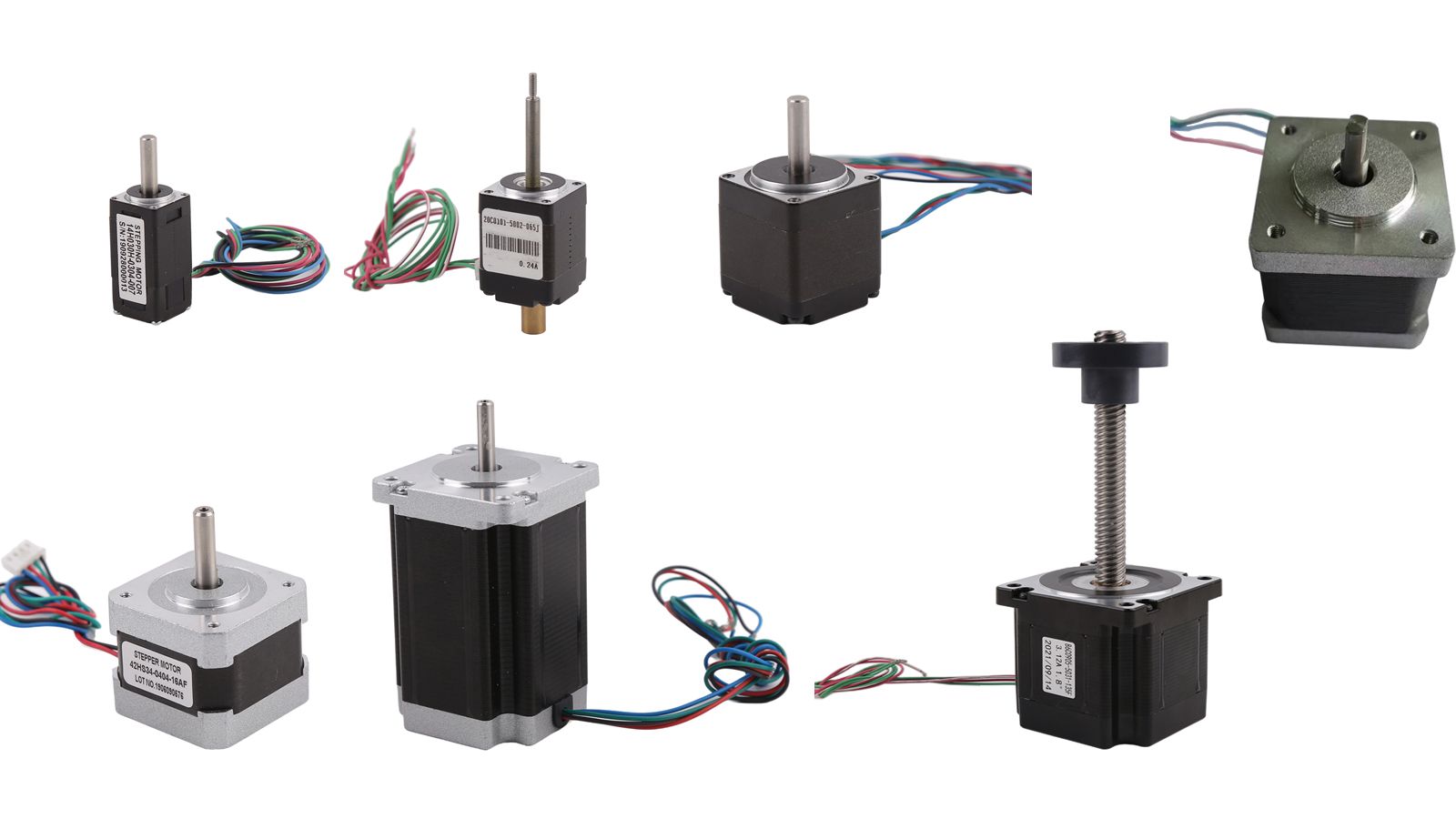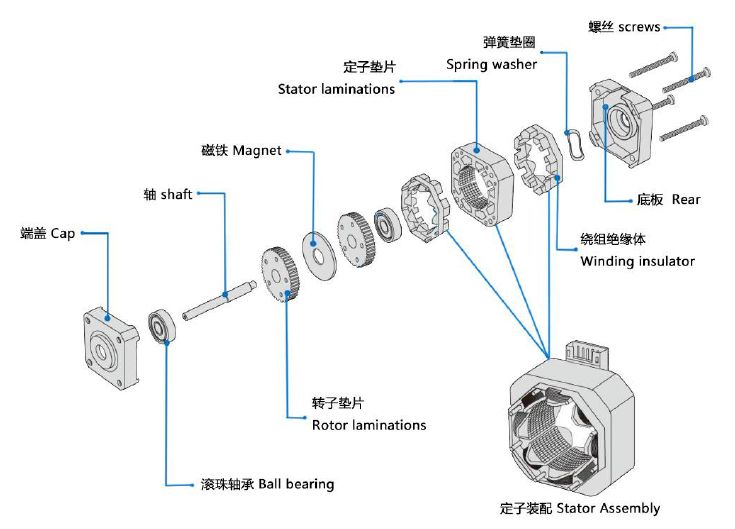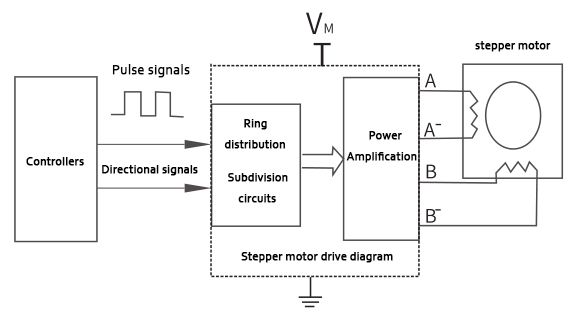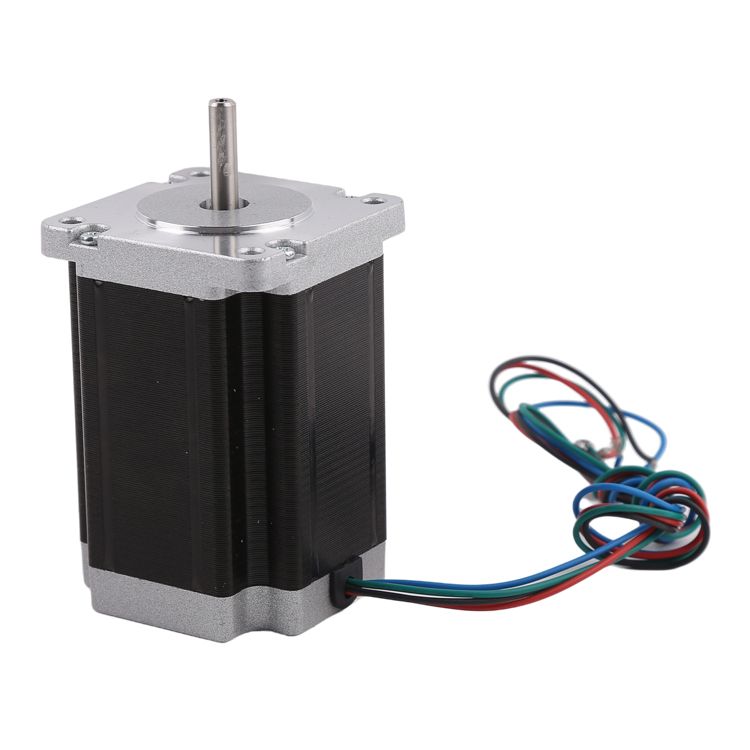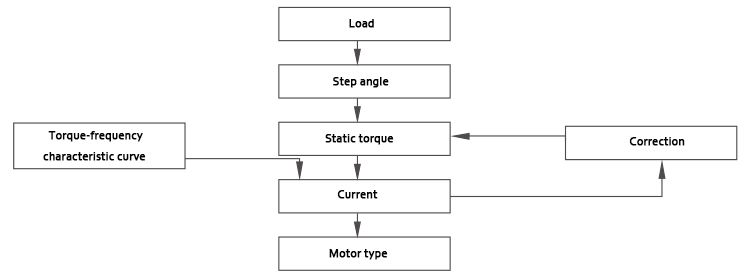স্টেপার মোটরপ্রতিক্রিয়া ডিভাইস (অর্থাৎ ওপেন-লুপ নিয়ন্ত্রণ) ব্যবহার না করে গতি নিয়ন্ত্রণ এবং অবস্থান নিয়ন্ত্রণের জন্য ব্যবহার করা যেতে পারে, তাই এই ড্রাইভ সমাধানটি অর্থনৈতিক এবং নির্ভরযোগ্য উভয়ই। অটোমেশন সরঞ্জাম, যন্ত্রগুলিতে, স্টেপার ড্রাইভ ব্যাপকভাবে ব্যবহৃত হয়েছে। তবে উপযুক্ত স্টেপার মোটর কীভাবে নির্বাচন করবেন, স্টেপার ড্রাইভের সর্বোত্তম কর্মক্ষমতা কীভাবে করবেন বা কীভাবে আরও প্রশ্ন রয়েছে সে সম্পর্কে অনেক প্রযুক্তিগত কর্মীর প্রশ্ন রয়েছে। এই গবেষণাপত্রে স্টেপার মোটর নির্বাচন নিয়ে আলোচনা করা হয়েছে, কিছু স্টেপার মোটর ইঞ্জিনিয়ারিং অভিজ্ঞতার প্রয়োগের উপর দৃষ্টি নিবদ্ধ করে, আমি আশা করি অটোমেশন সরঞ্জামগুলিতে স্টেপার মোটরগুলির জনপ্রিয়করণ একটি ভূমিকা পালন করবে।
১, ভূমিকাস্টেপার মোটর
স্টেপার মোটরকে পালস মোটর বা স্টেপ মোটরও বলা হয়। ইনপুট পালস সিগন্যাল অনুসারে উত্তেজনার অবস্থা পরিবর্তন করার সময় এটি একটি নির্দিষ্ট কোণে অগ্রসর হয় এবং উত্তেজনার অবস্থা অপরিবর্তিত থাকলে একটি নির্দিষ্ট অবস্থানে স্থির থাকে। এটি স্টেপার মোটরকে ইনপুট পালস সিগন্যালকে আউটপুটের জন্য সংশ্লিষ্ট কৌণিক স্থানচ্যুতিতে রূপান্তর করতে দেয়। ইনপুট পালসের সংখ্যা নিয়ন্ত্রণ করে আপনি সর্বোত্তম অবস্থান অর্জনের জন্য আউটপুটের কৌণিক স্থানচ্যুতি সঠিকভাবে নির্ধারণ করতে পারেন; এবং ইনপুট পালসের ফ্রিকোয়েন্সি নিয়ন্ত্রণ করে আপনি আউটপুটের কৌণিক গতি সঠিকভাবে নিয়ন্ত্রণ করতে পারেন এবং গতি নিয়ন্ত্রণের উদ্দেশ্য অর্জন করতে পারেন। 1960 এর দশকের শেষের দিকে, বিভিন্ন ধরণের ব্যবহারিক স্টেপার মোটর তৈরি হয়েছিল এবং গত 40 বছরে দ্রুত বিকাশ ঘটেছে। স্টেপার মোটরগুলি ডিসি মোটর, অ্যাসিঙ্ক্রোনাস মোটর, পাশাপাশি সিঙ্ক্রোনাস মোটরগুলিকে পাশাপাশি রাখতে সক্ষম হয়েছে, যা একটি মৌলিক ধরণের মোটর হয়ে উঠেছে। তিন ধরণের স্টেপার মোটর রয়েছে: প্রতিক্রিয়াশীল (VR টাইপ), স্থায়ী চুম্বক (PM টাইপ) এবং হাইব্রিড (HB টাইপ)। হাইব্রিড স্টেপার মোটর স্টেপার মোটরের প্রথম দুটি রূপের সুবিধাগুলিকে একত্রিত করে। স্টেপার মোটরটিতে একটি রটার (রটার কোর, স্থায়ী চুম্বক, শ্যাফ্ট, বল বিয়ারিং), একটি স্টেটর (উইন্ডিং, স্টেটর কোর), সামনের এবং পিছনের প্রান্তের ক্যাপ ইত্যাদি থাকে। সবচেয়ে সাধারণ দুই-ফেজ হাইব্রিড স্টেপার মোটরে 8টি বড় দাঁত, 40টি ছোট দাঁত এবং 50টি ছোট দাঁত সহ একটি রটার সহ একটি স্টেটর থাকে; একটি তিন-ফেজ মোটরে 9টি বড় দাঁত, 45টি ছোট দাঁত এবং 50টি ছোট দাঁত সহ একটি রটার সহ একটি স্টেটর থাকে।
২, নিয়ন্ত্রণ নীতি
দ্যস্টেপার মোটরবিদ্যুৎ সরবরাহের সাথে সরাসরি সংযুক্ত করা যাবে না, অথবা এটি সরাসরি বৈদ্যুতিক পালস সংকেত গ্রহণ করতে পারবে না, এটি একটি বিশেষ ইন্টারফেসের মাধ্যমে বাস্তবায়ন করতে হবে - স্টেপার মোটর ড্রাইভার যা পাওয়ার সাপ্লাই এবং কন্ট্রোলারের সাথে ইন্টারঅ্যাক্ট করবে। স্টেপার মোটর ড্রাইভার সাধারণত একটি রিং ডিস্ট্রিবিউটর এবং একটি পাওয়ার এমপ্লিফায়ার সার্কিট দিয়ে গঠিত। রিং ডিভাইডার কন্ট্রোলার থেকে কন্ট্রোল সিগন্যাল গ্রহণ করে। প্রতিবার পালস সিগন্যাল পাওয়ার সময় রিং ডিভাইডারের আউটপুট একবার রূপান্তরিত হয়, তাই পালস সিগন্যালের উপস্থিতি বা অনুপস্থিতি এবং ফ্রিকোয়েন্সি নির্ধারণ করতে পারে যে স্টেপার মোটরের গতি বেশি নাকি কম, শুরু বা বন্ধ করার জন্য ত্বরান্বিত হচ্ছে নাকি হ্রাস পাচ্ছে। রিং ডিস্ট্রিবিউটরকে কন্ট্রোলার থেকে দিকনির্দেশনা সংকেত পর্যবেক্ষণ করতে হবে যাতে তার আউটপুট স্টেট ট্রানজিশন ইতিবাচক বা নেতিবাচক ক্রমে আছে কিনা তা নির্ধারণ করা যায় এবং এইভাবে স্টেপার মোটরের স্টিয়ারিং নির্ধারণ করা যায়।
3, প্রধান পরামিতি
①ব্লক নম্বর: মূলত ২০, ২৮, ৩৫, ৪২, ৫৭, ৬০, ৮৬, ইত্যাদি।
②ফেজ নম্বর: স্টেপার মোটরের ভিতরে কয়েলের সংখ্যা, স্টেপার মোটর ফেজ নম্বরে সাধারণত দুই-ফেজ, তিন-ফেজ, পাঁচ-ফেজ থাকে। চীন মূলত দুই-ফেজ স্টেপার মোটর ব্যবহার করে, তিন-ফেজেরও কিছু অ্যাপ্লিকেশন রয়েছে। জাপানে প্রায়শই পাঁচ-ফেজ স্টেপার মোটর ব্যবহার করা হয়।
③ধাপের কোণ: একটি পালস সংকেতের সাথে সঙ্গতিপূর্ণ, মোটর রটার ঘূর্ণনের কৌণিক স্থানচ্যুতি। স্টেপার মোটর ধাপের কোণ গণনার সূত্রটি নিম্নরূপ
ধাপ কোণ = 360° ÷ (2mz)
একটি স্টেপার মোটরের পর্যায় সংখ্যা m
Z একটি স্টেপার মোটরের রটারের দাঁতের সংখ্যা।
উপরের সূত্র অনুসারে, দুই-ফেজ, তিন-ফেজ এবং পাঁচ-ফেজ স্টেপার মোটরের ধাপ কোণ যথাক্রমে 1.8°, 1,2° এবং 0.72°
④ হোল্ডিং টর্ক: হল মোটরের স্টেটর উইন্ডিংয়ের টর্ক যা রেট করা কারেন্টের মধ্য দিয়ে যায়, কিন্তু রটারটি ঘোরে না, স্টেটরটি রটারটিকে লক করে। হোল্ডিং টর্ক হল স্টেপার মোটরের সবচেয়ে গুরুত্বপূর্ণ প্যারামিটার এবং মোটর নির্বাচনের প্রধান ভিত্তি।
⑤ পজিশনিং টর্ক: মোটর যখন কারেন্ট পাস করে না তখন বাহ্যিক বল দিয়ে রটার ঘুরানোর জন্য প্রয়োজনীয় টর্ক। টর্ক হল মোটর মূল্যায়নের জন্য কর্মক্ষমতা সূচকগুলির মধ্যে একটি, অন্যান্য পরামিতিগুলির ক্ষেত্রে একই রকম, পজিশনিং টর্ক যত ছোট হবে তার অর্থ হল "স্লট প্রভাব" ছোট হবে, কম গতিতে চলমান মোটরের মসৃণতার জন্য তত বেশি উপকারী টর্ক ফ্রিকোয়েন্সি বৈশিষ্ট্য: মূলত টানা টর্ক ফ্রিকোয়েন্সি বৈশিষ্ট্যগুলিকে বোঝায়, একটি নির্দিষ্ট গতিতে মোটর স্থিতিশীল অপারেশন ধাপ না হারিয়ে সর্বাধিক টর্ক সহ্য করতে পারে। ধাপের ক্ষতি ছাড়াই সর্বাধিক টর্ক এবং গতি (ফ্রিকোয়েন্সি) এর মধ্যে সম্পর্ক বর্ণনা করতে মুহূর্ত-ফ্রিকোয়েন্সি বক্ররেখা ব্যবহার করা হয়। টর্ক ফ্রিকোয়েন্সি বক্ররেখা স্টেপার মোটরের একটি গুরুত্বপূর্ণ প্যারামিটার এবং মোটর নির্বাচনের প্রধান ভিত্তি।
⑥ রেটেড কারেন্ট: রেটেড টর্ক বজায় রাখার জন্য প্রয়োজনীয় মোটর উইন্ডিং কারেন্ট, কার্যকর মান
৪, পয়েন্ট নির্বাচন করা
স্টেপার মোটর ব্যবহারে ব্যবহৃত শিল্প অ্যাপ্লিকেশনগুলির গতি 600 ~ 1500rpm পর্যন্ত, উচ্চ গতির জন্য, আপনি ক্লোজড-লুপ স্টেপার মোটর ড্রাইভ বিবেচনা করতে পারেন, অথবা আরও উপযুক্ত সার্ভো ড্রাইভ প্রোগ্রাম স্টেপার মোটর নির্বাচনের ধাপগুলি বেছে নিতে পারেন (নীচের চিত্রটি দেখুন)।
(1) ধাপ কোণের পছন্দ
মোটরের ফেজের সংখ্যা অনুসারে, তিন ধরণের স্টেপ অ্যাঙ্গেল রয়েছে: ১.৮° (দুই-ফেজ), ১.২° (তিন-ফেজ), ০.৭২° (পাঁচ-ফেজ)। অবশ্যই, পাঁচ-ফেজ স্টেপ অ্যাঙ্গেলের নির্ভুলতা সর্বাধিক তবে এর মোটর এবং ড্রাইভার বেশি ব্যয়বহুল, তাই এটি চীনে খুব কমই ব্যবহৃত হয়। এছাড়াও, মূলধারার স্টেপার ড্রাইভাররা এখন সাবডিভিশন ড্রাইভ প্রযুক্তি ব্যবহার করছে, নীচের ৪টি সাবডিভিশনে, সাবডিভিশন স্টেপ অ্যাঙ্গেলের নির্ভুলতা এখনও নিশ্চিত করা যেতে পারে, তাই যদি বিবেচনা থেকে শুধুমাত্র স্টেপ অ্যাঙ্গেল নির্ভুলতা সূচক থাকে, তাহলে পাঁচ-ফেজ স্টেপার মোটরকে দুই-ফেজ বা তিন-ফেজ স্টেপার মোটর দ্বারা প্রতিস্থাপন করা যেতে পারে। উদাহরণস্বরূপ, ৫ মিমি স্ক্রু লোডের জন্য কোন ধরণের সীসা প্রয়োগের ক্ষেত্রে, যদি একটি দুই-ফেজ স্টেপিং মোটর ব্যবহার করা হয় এবং ড্রাইভারটি ৪টি উপবিভাগে সেট করা থাকে, মোটরের প্রতি ঘূর্ণনে পালসের সংখ্যা ২০০ x ৪ = ৮০০ হয়, এবং পালসের সমতুল্য ৫ ÷ ৮০০ = ০.০০৬২৫ মিমি = ৬.২৫μm হয়, তাহলে এই নির্ভুলতা বেশিরভাগ প্রয়োগের প্রয়োজনীয়তা পূরণ করতে পারে।
(২) স্ট্যাটিক টর্ক (হোল্ডিং টর্ক) নির্বাচন
সাধারণত ব্যবহৃত লোড ট্রান্সমিশন মেকানিজমের মধ্যে রয়েছে সিঙ্ক্রোনাস বেল্ট, ফিলামেন্ট বার, র্যাক এবং পিনিয়ন ইত্যাদি। গ্রাহকরা প্রথমে তাদের মেশিন লোড (প্রধানত ত্বরণ টর্ক প্লাস ঘর্ষণ টর্ক) গণনা করেন যা মোটর শ্যাফ্টের প্রয়োজনীয় লোড টর্কে রূপান্তরিত হয়। তারপর, বৈদ্যুতিক ফ্লাওয়ারগুলির জন্য প্রয়োজনীয় সর্বাধিক চলমান গতি অনুসারে, স্টেপার মোটরের উপযুক্ত হোল্ডিং টর্ক বেছে নেওয়ার জন্য নিম্নলিখিত দুটি ভিন্ন ব্যবহারের ক্ষেত্রে ① 300pm বা তার কম গতির প্রয়োজনীয় মোটর গতি প্রয়োগের জন্য: যদি মেশিন লোড মোটর শ্যাফ্টের প্রয়োজনীয় লোড টর্ক T1 তে রূপান্তরিত হয়, তাহলে এই লোড টর্কটিকে একটি সুরক্ষা ফ্যাক্টর SF (সাধারণত 1.5-2.0 হিসাবে নেওয়া হয়) দ্বারা গুণ করা হয়, অর্থাৎ, প্রয়োজনীয় স্টেপার মোটর হোল্ডিং টর্ক Tn ②2 300pm বা তার বেশি গতির প্রয়োজন এমন অ্যাপ্লিকেশনগুলির জন্য: সর্বোচ্চ গতি Nmax সেট করুন, যদি মেশিন লোড মোটর শ্যাফ্টে রূপান্তরিত হয়, তবে প্রয়োজনীয় লোড টর্ক T1 হয়, তাহলে এই লোড টর্কটিকে একটি সুরক্ষা ফ্যাক্টর SF (সাধারণত 2.5-3.5) দ্বারা গুণ করা হয়, যা হোল্ডিং টর্ক Tn দেয়। চিত্র ৪ দেখুন এবং একটি উপযুক্ত মডেল নির্বাচন করুন। তারপর পরীক্ষা এবং তুলনা করার জন্য মোমেন্ট-ফ্রিকোয়েন্সি বক্ররেখা ব্যবহার করুন: মোমেন্ট-ফ্রিকোয়েন্সি বক্ররেখায়, ব্যবহারকারীর দ্বারা প্রয়োজনীয় সর্বাধিক গতি Nmax T2 এর সর্বাধিক হারানো ধাপ টর্কের সাথে মিলে যায়, তারপর সর্বাধিক হারানো ধাপ টর্ক T2 T1 এর চেয়ে 20% এর বেশি হওয়া উচিত। অন্যথায়, বৃহত্তর টর্ক সহ একটি নতুন মোটর নির্বাচন করা প্রয়োজন, এবং নতুন নির্বাচিত মোটরের টর্ক ফ্রিকোয়েন্সি বক্ররেখা অনুসারে আবার পরীক্ষা এবং তুলনা করা উচিত।
(৩) মোটরের বেস নম্বর যত বড় হবে, হোল্ডিং টর্ক তত বেশি হবে।
(৪) রেট করা বর্তমান অনুযায়ী ম্যাচিং স্টেপার ড্রাইভার নির্বাচন করুন।
উদাহরণস্বরূপ, একটি মোটর 57CM23 এর রেট করা কারেন্ট 5A, তাহলে আপনি ড্রাইভের সর্বোচ্চ অনুমোদিত কারেন্ট 5A এর বেশি হলে মিলবেন (দয়া করে মনে রাখবেন এটি সর্বোচ্চ মান নয় বরং কার্যকর মান), অন্যথায় যদি আপনি কেবলমাত্র 3A ড্রাইভের সর্বোচ্চ কারেন্ট বেছে নেন, তাহলে মোটরের সর্বোচ্চ আউটপুট টর্ক মাত্র 60% হতে পারে!
৫, আবেদনের অভিজ্ঞতা
(1) স্টেপার মোটর কম ফ্রিকোয়েন্সি অনুরণন সমস্যা
স্টেপার মোটরের কম ফ্রিকোয়েন্সি রেজোন্যান্স কমানোর জন্য সাবডিভিশন স্টেপার ড্রাইভ একটি কার্যকর উপায়। ১৫০rpm এর নিচে, সাবডিভিশন ড্রাইভ মোটরের কম্পন কমাতে খুবই কার্যকর। তাত্ত্বিকভাবে, সাবডিভিশন যত বড় হবে, স্টেপার মোটরের কম্পন কমানোর উপর প্রভাব তত ভালো হবে, কিন্তু প্রকৃত পরিস্থিতি হল স্টেপার মোটরের কম্পন কমানোর উপর উন্নতির প্রভাব চরমে পৌঁছানোর পরে সাবডিভিশন ৮ বা ১৬ তে বৃদ্ধি পায়।
সাম্প্রতিক বছরগুলিতে, দেশে এবং বিদেশে অ্যান্টি-লো-ফ্রিকোয়েন্সি রেজোন্যান্স স্টেপার ড্রাইভার তালিকাভুক্ত করা হয়েছে, লেইসাইয়ের ডিএম, ডিএম-এস সিরিজের পণ্য, অ্যান্টি-লো-ফ্রিকোয়েন্সি রেজোন্যান্স প্রযুক্তি। এই সিরিজের ড্রাইভারগুলি সুরেলা ক্ষতিপূরণ ব্যবহার করে, প্রশস্ততা এবং ফেজ ম্যাচিং ক্ষতিপূরণের মাধ্যমে, স্টেপার মোটরের কম ফ্রিকোয়েন্সি কম্পনকে ব্যাপকভাবে হ্রাস করতে পারে, যাতে মোটরের কম কম্পন এবং কম শব্দ অপারেশন অর্জন করা যায়।
(২) অবস্থান নির্ভুলতার উপর স্টেপার মোটর উপবিভাগের প্রভাব
স্টেপার মোটর সাবডিভিশন ড্রাইভ সার্কিট কেবল ডিভাইসের চলাচলের মসৃণতা উন্নত করতে পারে না, বরং কার্যকরভাবে সরঞ্জামের অবস্থান নির্ভুলতাও উন্নত করতে পারে। পরীক্ষাগুলি দেখায় যে: সিঙ্ক্রোনাস বেল্ট ড্রাইভ মোশন প্ল্যাটফর্মে, স্টেপার মোটর 4 সাবডিভিশনে, মোটরটি প্রতিটি ধাপে সঠিকভাবে অবস্থান করা যেতে পারে।
পোস্টের সময়: জুন-১১-২০২৩

